Cunningham Cabin in Grand Teton National Park is a scenic icon and offers amazing photography and history.
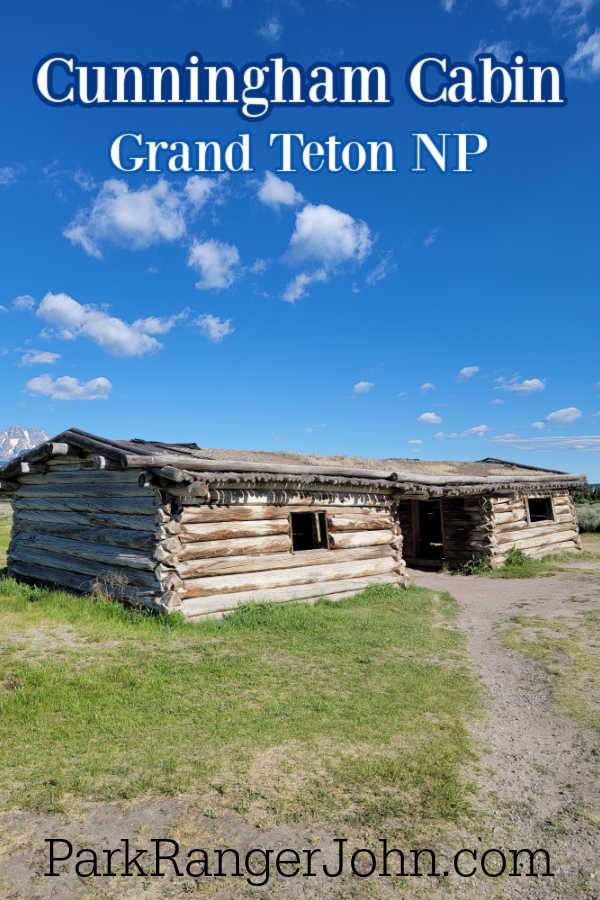
TL;DR Don’t have time to read the full article? Here are my top finds:
🏨Hotels and Vacation Rentals
📍Tours
🐻 Save time! Buy your National Park Pass before your trip
Cunningham Cabin - Grand Teton National Park
You may have seen the iconic Grand Teton National Park photo through a historic window with views of the Teton Range.
This photo is taken through the historic Cunningham Cabin. You can easily take this photo by taking a short walk to the cabin.
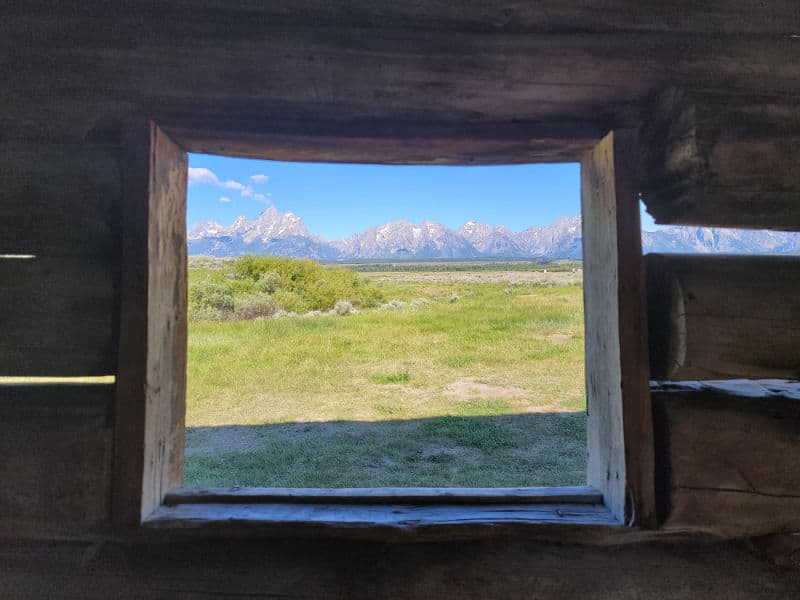
This historic Cunningham Ranch cabin was established as the Bar Flying U Ranch by J. Pierce Cunningham in the 1880s. Today this cabin is one of the few remaining homesteading era cabins in Jackson Hole.
When visiting the Cunningham Cabin, you can walk to the cabin and take a 30-minute walk around the property.
If you walk around the property, you have the opportunity to see the foundation of the original barn, shed foundation, depressions that remain from the outhouses, and remains of the fenced corral.
When visiting the cabin, you will notice the floors are dirt. When the Cunninghams lived in the cabin, they lived with the dirt floor and swept it to keep it clean.
The cabin is constructed in a "dog trot" style also called a double pen log cabin. This style consists of two small cabins joined by an open-covered breezeway.
The logs of the cabin were secured with saddle notches in the corner. The roof was constructed with sapling poles that had dirt and earth piled on top of it.
When you look at the cabin you will notice that no nails or metal fasteners were used to construct the cabin.
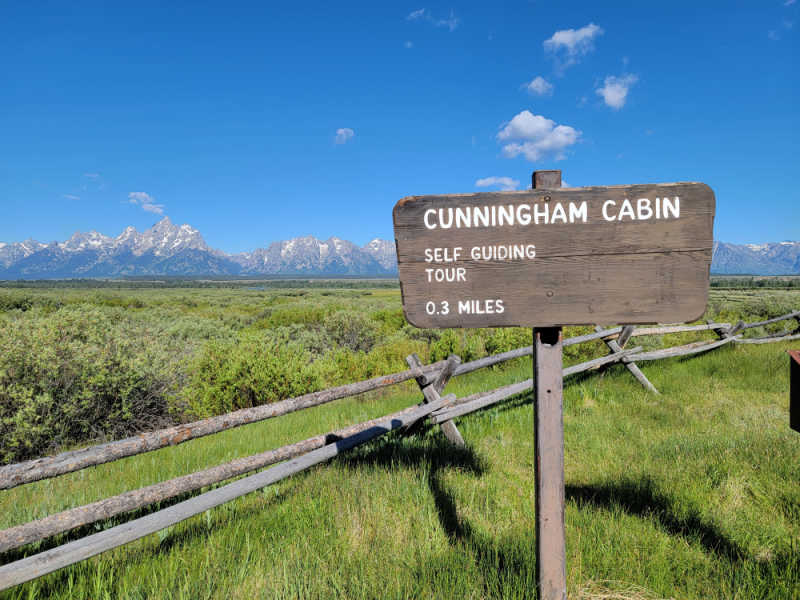
How to get to Cunningham Cabin
The Cunningham Cabin is located north on Highway 191 near the eastern boundary of the park.
Parking - There is a nice size parking lot right next to the trailhead. The cabin is only a tenth of a mile from the parking lot.
It is a short walk from the parking lot to explore this historic area of Grand Teton NP. There is a dirt trail with a few steps to reach the main area.
While exploring the grass area around the cabin, keep an eye out for holes in the ground. There are ground squirrels all over the place, and their holes are common.
Keep an eye out for bison in the area. This area is incredibly popular for single bison and large herds of them.
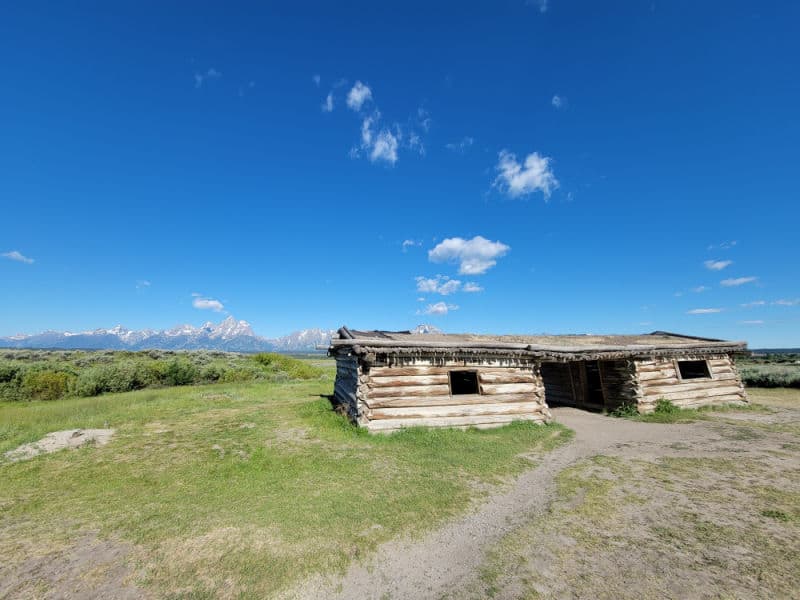
Things to know
You will not be able to see the cabin from the highway. Once you reach the parking lot you will see the Cunningham Ranch sign and the cabin nearby.
There are times when wildfire smoke blows into the valley and covers the mountains from view. We had this happen during a visit and could not see the Teton Mountain Range even when close by.
You can buy a brochure with more information on the cabin for $1 cash near the trailhead. The brochure is produced by the Grand Teton Association.
There are no bathrooms.
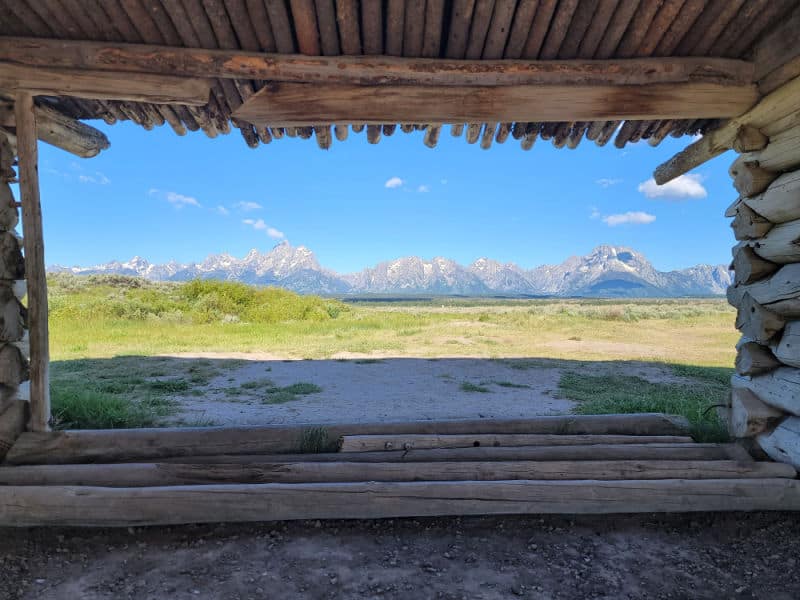
History
John Pierce Cunningham first arrived in Jackson Hole around 1885 from New York. He was twenty years old when he arrived.
Between 1888 and 1890 Mr. Cunningham and his new bridge Margaret staked a homestead claim in the current location of the cabin.
Their original ranch was 160 acres which was the allowed acreage for the Homestead Act of 1862. The Homestead Act required homesteaders to live on the land for five years and to meet specific requirements.
These included building a cabin at least twelve feet by twelve feet and cultivate a few acres of crops.
Once they could prove their claim and they met the requirements the land was theirs.
The Cunninghams had to learn to adapt to ranching in the Teton Valley. Congress passed the Desert Land Act in 8177 which allowed rancher to increase their ranches past the 160 acres that were allowed in the Homestead Act.
Ranchers could purchase additional acreage for $1.25 per acre. Mr. Cunningham file a Desert Land Entry for an additional 140 acres in 1897. The land was for grazing and cultivating hay.
He purchased 240 acres from James and Lydia Uhl's property in 1918. The hay allowed ranchers to survive the long bitterly cold winter that includes deep snow. The hay had to last the 6 months of winter.
In April of 1893, there was an incident at the Bar Flying U Ranch that is still a mystery. During the fall of 1892, two wranglers from Montana approached Mr Cunningham looking to buy hay for their horses.
George Spencer and Mike Burnett struck a deal with Mr. Cunningham to winter over on the ranch. During that winter there were rumors swirling that the two men were horse thieves.
In the spring a man who claimed to be a US Marshall came to Jackson Hole accompanied by three deputies. They convinced a few men from Jackso to form a posse to apprehend the alleged thieves.
The posse surrounded the cabin ranch at night and waited for morning. In the morning when the two men left the cabin they were gunned down.
The truth of the Marshall's identity and allegations were never proven.
Staring in the 1900s, Mr. Cunningham started profiting from calf prices. He was able to invest in his ranch with the extra profit which allowed him to purchase the additional property from the Uhls in 1918.
Unfortunately, in the summer of 1918 was one of extreme drought which caused hay crops to shrivel up. The end of World War I also caused the calf prices to plunge.
This drought continued through the 1920s which made ranch foreclosures a common event. After the plunge of cattle prices and the drought, there was a movement to include the Teton Range and Jackson Hole valley in Yellowstone National Park which had been created in 1872.
Horace M. Albright who was the superintendent of Yellowstone in 1923 met with local residents and ranchers to develop a plan to protect the valley and mountains.
Mr. Cunningham along with another rancher Si Ferrin co-authored a petition. The petition was signed by 97 ranchers and outlined a proposal for the federal government or a private entity to buy out the ranchers.
The petition proposed that the entire Jackson Hole should be set aside to be a recreational area for the education and enjoyment of the nation.
This idea was brought to John D. Rockefeller Jr and his family who was touring through Jackson Hole. Mr. Rockefeller Jr was enthusiastic about a national park in the Teton Range. He created the Snake River Land Company in 1927 and began purchasing private land at a fair market price.
Grand Teton National Park was created in 1929 but only included the mountain range and Piedmont Lakes at the time of creation.
Over time Mr. Rockefeller purchased 32,000 acres and later donated the land to the federal government to become part of Jackson Hole National Monument. Ultimately the land was included in today's Grand Teton NP.
In 1928, the Cunninghams sold their Flying Bar U Ranch to the Snake River Land Company and retired to Victor, Idaho.
Today the Cunningham Cabin represents the spirit of homesteading ranchers that helped shape the character of Jackson Hole.
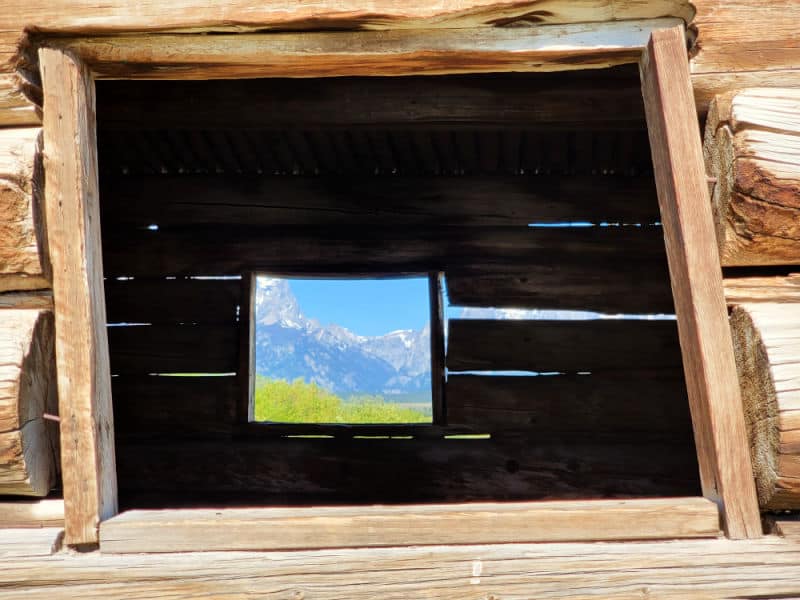
Additional Grand Teton National Park Information & Resources
Grand Teton National Park Guided Tours
Tetons and Snake River Scenic Float Trip in Jackson Hole
⭐️ Rating: 4.8 out of 5 Stars | ⏳ Tour Length: 3 hours | 🛶Check Rates and Availability
This would be, without a doubt, the tour I would choose! Take a relaxing rafting trip from Jackson Hole, drift down a scenic section of Wyoming's wildlife-laden Snake River, where moose, deer, river otters, and eagles can be seen from your raft. Be sure to bring your camera to photograph any wildlife that appears on the banks, and also capture the stunning landscape extending out from the Tetons.
Grand Teton Wildlife Safari in an enclosed or Open-Air Vehicle
⭐️ Rating: 4.9 out of 5 Stars | ⏳ Tour Length: 4 hours | 🚌Check Rates and Availability
Join a local naturalist and guide for a ride in an open-air safari vehicle (seasonal) on dirt roads and on paved highways within Grand Teton National Park, where you scour the landscape at dawn or dusk for wolves, moose and elk. Look for eagles soaring overhead or deer walking through the woods, and there's even a chance that you can spot a bear roaming near the road. The guides also discusses the areas ecology, history, geology, and culture, and also stops so that you can take photos.
Grand Teton Half-Day Tour
⭐️ Rating: 4.8 out of 5 Stars | ⏳ Tour Length: 4 hours | 🚌Check Rates and Availability
Explore the highlights of Grand Teton National Park from either Jackson or Teton Village. Travel along the Gros Ventre River to the Mormon Row Historic District, Moose Junction, and other places where wildlife roam. Use the provided spotting scope and field glasses to get a close look at the animals like moose, elk, and eagles.
Grand Teton National Park Lodging Options
Lodging in Grand Teton National Park
Grand Teton National Park has several National Park lodges, including Signal Mountain Lodge, Jenny Lake Lodge, Jackson Lake Lodge, Headwaters at Flagg Ranch, Triangle X Dude Ranch, and Colter Bay Village Cabins.
Signal Mountain Lodge
🏨Ready to Book the Signal Mountain Lodge -> Click Here
Why Book here? How about rooms with jaw-dropping EPIC Views of Jackson Lake in the foreground and the Tetons in the background! There is nothing quite like sitting on the deck with a cup of coffee watching sunrise. The Signal Mountain Lodge is open from Early May to mid - October.
Jenny Lake Lodge
🏨Ready to Book the Jenny Lake Lodge -> Click Here
Why stay here? This is by far, the closest accomodations to Jenny Lake and all of its wonders! Now you can get to the parking lot early and beat the insane crowds trying to get to this piece of heaven. The cabins are secluded and located east of Jenny Lake, this resort is a high-class destination for the well-pampered traveler. The dining room offers a prix fixe menu with a local and international flair. Open Early June to Early October.
Jackson Lake Lodge
🏨Ready to Book the Jackson Lake Lodge -> Click Here
Why stay here? The main lodge area is absolutely EPIC with sweeping panoramic views of the Teton Range and Signal Mountain from the full wall of windows! Don't forget to hang out by the fireplace and stop in a restaurant to enjoy the full lodge experience.
With spectacular dining in the world-renowned Mural Room, shopping opportunities in its three gift shops, guided activities, and a comprehensive conference facility. Its easy to see why this lodge draws thousands of guests from May through October each year.
Headwaters at Flagg Ranch
🏨Ready to Book the Headwaters at Flagg Ranch -> Click Here
- Season - Early June to Late September
Why stay here? Location, Location, Location! The Headwaters Lodge at Flagg Ranch is actually located on the Rockefeller Memorial Parkway just South of Grand Teton National Park, and just North of Yellowstone National Park. The cabins are very nice and makes it easy to explore both parks in one convient location.
Colter Bay Village Cabins
🏨Ready to Book the Colter Bay Village Cabins -> Click Here
Why stay here? these cabins are so cute and give the log cabin feel! They also provide easy access to the Colter Bay Marina and village. The historic cabins are over 90 years old and feel like you are stepping back in time but still have modern amenities. Open from Late May to Late September.
Lodging near Grand Teton National Park
Four Seasons Resort Jackson Hole
🏨Ready to Book the -> Click Here
Do you want to stay in a hotel with 5-star old luxury charm, phenomonal spa treatments, concierge, and delicious dining? Consider a stay at Four Seasons Resort Jackson Hole and take advantage of the nightclub, and a terrace. Yoga classes are offered at the health club. Free in-room Wi-Fi is available to all guests, along with a hair salon and an arcade/game room.
Fireside Resort
🏨Ready to Book the Fireside Resort -> Click Here
Why Stay here? Super cute small cabins right off the Moose-Wilson Road! Cabins feature a spa tub, coffee/tea in a common area, and concierge services. Free Wi-Fi in public areas and free self parking are also provided. Additionally, laundry facilities, tour/ticket assistance, and a garden are onsite. All 20 cabins boast fireplaces and offer free Wi-Fi and kitchens. Patios and living rooms are standard, as are flat-screen TVs with cable channels.
Click on the map below to see additional vacation rentals and lodging options near the park.
Grand Teton National Park Entrance Fee
Park entrance fees are separate from camping and lodging fees.
Park Entrance Pass - $35.00 Per private vehicle (valid for 1-7 days from the date of purchase)
Park Entrance Pass - Motorcycle - $30.00 Per motorcycle (valid for 1-7 days from the date of purchase)
Per-Person Entrance Pass - $20.00 Visitors 16 years or older who enter on foot, bicycle, or as part of an organized group not involved in a commercial tour.
Annual Park Entrance Pass - $70.00, Admits pass holder and all passengers in a non-commercial vehicle. Valid for one year from the month of purchase.
$25.00 for Commercial Sedan with 1-6 seats and non-commercial groups (16+ persons)
$125.00 for Commercial Van with 7-15 seats
$200.00 for Commercial Mini-Bus with 16-25 seats
$300.00 for Commercial Motor Coach with 26+ seats
Learn more about National Park Passes for parks that have an entrance fee.
$80.00 - For the America the Beautiful/National Park Pass. The pass covers entrance fees to all US National Park Sites and over 2,000 Federal Recreation Fee Sites for an entire year and covers everyone in the car for per-vehicle sites and up to 4 adults for per-person sites.

Buy your pass at this link, and REI will donate 10% of pass proceeds to the National Forest Foundation, National Park Foundation, and the U.S. Endowment for Forestry & Communities.
National Park Free Entrance Days -Mark your calendars with the free entrance days the National Park Service offers for US citizens and residents.
Don't Miss these great sites in the park!
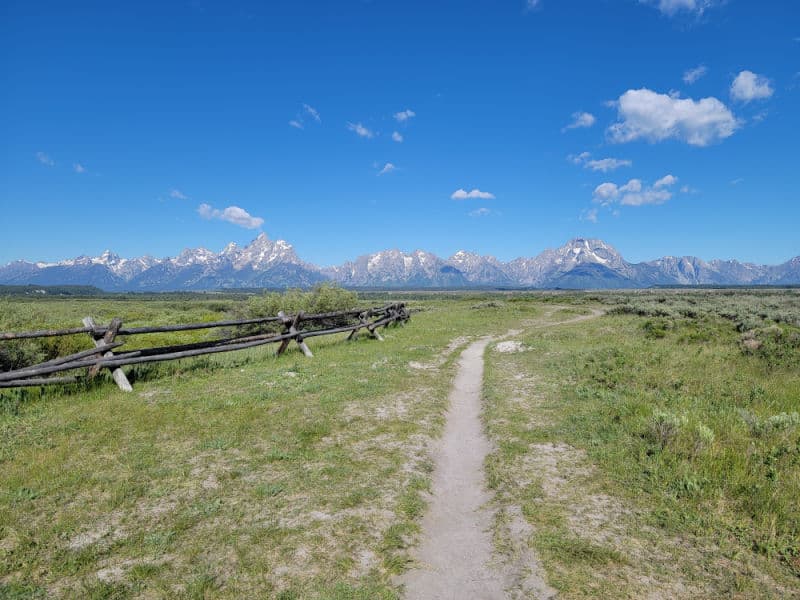
Additional Grand Teton Resources
Top things to do in Grand Teton
Check out all of the great National Parks in Wyoming along with neighboring Colorado National Parks, Idaho National Parks, National Parks in Utah, Nevada National Parks, Arizona National Parks, and New Mexico National Parks.
Make sure to follow Park Ranger John on Facebook, Instagram, Pinterest, and TikTok

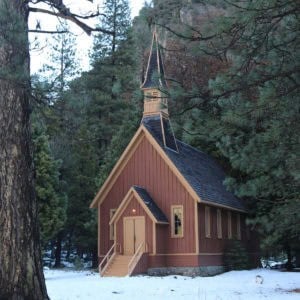
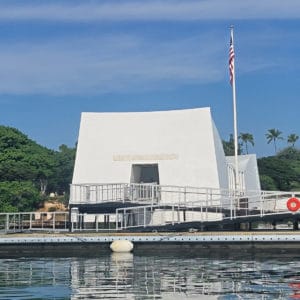
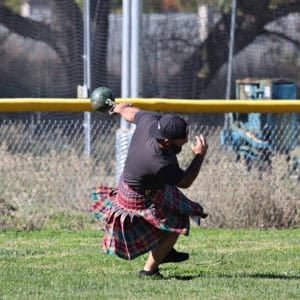

Leave a Reply